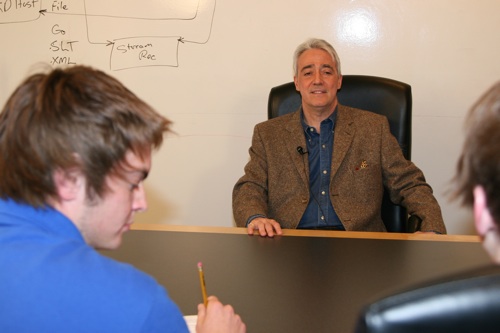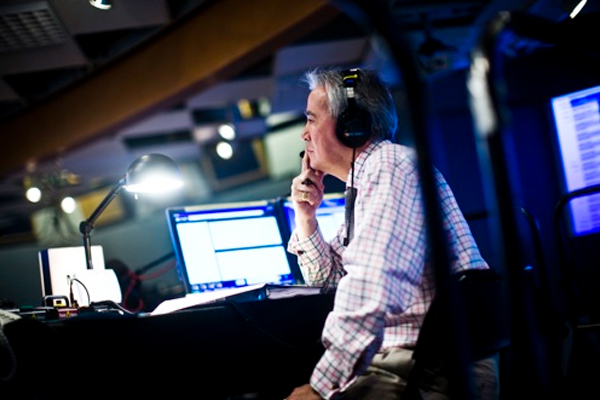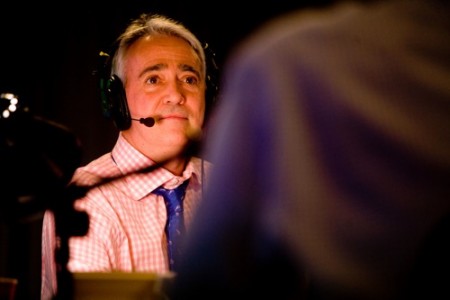Power of the Question
Lesson 2: Research-Based Questions
WARM-UP ACTIVITY

Scott Simon in the NPR studio.
In their journals, ask students to free-write in response to these questions: Think about the professional journalist you watched or listened to for homework last night. How did he or she use naïve questions? What kinds of responses were elicited from naïve questions? Were naïve questions useful? How?
After students have had time to respond, ask students to share their experiences with the homework assignment and reflect on the use of naïve questions in the media. Post some responses on a chart that can be used for future assignments.
CONCEPT FORMATION
Ask students: How do you think professional journalists decide which questions to ask? What kind of research do journalists have to do in advance to be able to write good questions?
Introduce the research section of the Simon video, which features the role of research in question formation. Ask students to listen for Simon’s explanation of how research can be used to develop questions. Encourage students to take notes during the video.
After watching the video, have students discuss Simon’s views on using research to develop questions. What examples does Simon provide?
(You can watch the entire Simon video here.)
Use one of Simon’s radio interviews to hear more examples of how he uses research with his interviewees:
- Example: In his interview with Joan Allen, Scott Simon uses research to ask Allen about her father’s livelihood and how it affected her career choices.
- Jeremy Irons, Joan Allen Star In ‘Impressionism’ (March 07, 2009)
- Example: Simon interviewed Kinan Azmeh about his life and his music. He asked a simple, yet easy-to-overlook question about the guest’s decision to pick up the clarinet. His guest responded with an incredibly detailed story about his decision. How can research be used to elicit peoples’ stories?
- Kinan Azmeh: A Syrian Frequent Flier With Clarinet In Hand (March 07, 2009)
- Example: In July, Simon interviewed Tanya Tucker about early start in the music business after her release of a new album this summer. Without Simon’s knowledge of her history, he would have missed the importance of sharing with the audience something Tucker assumed everyone knew about Mel Tillis and the beginnings of her career.
- Tanya Tucker: Living In A Country Song (July 11, 2009)
As students are listening to the radio interviews, have them list examples of times when Simon uses research in his questions to build conversation or elicit stories.
After listening to one or more of these interviews, reflect on Simon’s use of research. How does he use research to improve his questions and the overall quality of his interviews?
APPLICATION
Place students in small groups. Assign each group an author or historical figure that connects to the class’ curriculum. Choose individuals who are relatively unfamiliar to students. Ask students to develop at least five interview questions for this person. Do not provide any further information about the individual at this time.
After students have developed their initial questions, give each group the chance to learn more about this author or historical figure. Depending on time, teachers may give each group a dossier or biography of this person, or allow students to research their selection on the Internet. Ask students to revise and improve their initial questions to reflect the knowledge they gained through their research. Ask students to write three additional questions after researching the person.
Ask each group to write one of their initial questions on the board. Beneath this initial question, ask the group to share how they revised their question to incorporate the research they learned about the person. Share each group’s experiences. Compare and contrast the quality of questions developed with and without the knowledge gained through researching the individual.
HOMEWORK
Pass out the following writing prompt to students: In school, we tend to think of using research to answer questions, but Simon is encouraging us to use research to write and create good questions. Think of a time when you have done research to help you ask a question (English class for research paper, American Studies and Film for interviews). Write at least one paragraph describing the research you did, the question you asked, and the response you got.
ALTERNATIVE ACTIVITY
The lesson below is from The New York Times Learning Network online, September 26, 2007
WARM-UP ACTIVITY
After students have been seated, they respond in their journals to the following question (written on the board prior to class): “Imagine a world leader who had gone on record as labeling the Holocaust a ‘myth,’ calling for Israel to be ‘wiped off the map,’ denouncing homosexuality, and who was suspected of harboring a secret nuclear weapons program, is in town for a diplomatic meeting. Do you think this person should be invited to speak publicly? Why or why not? Support your position.”
Allow students several minutes to write, and then have several volunteers share their responses with the class. Ask them to which current world leader the description in the journal prompt refers. If students are unfamiliar with Mahmoud Ahmadinejad, you may wish to spend a few minutes offering a brief overview of his policies and Iran’s role in the context of current world affairs. For more information on Mr. Ahmadinejad, see The New York Times “Times Topics” page .
CONCEPT FORMATION
As a class, read and discuss the article “Ahmadinejad, at Columbia, Parries and Puzzles” focusing on the following questions:
- Why did Iran’s president, Mahmoud Ahmadinejad, speak at Columbia University on September 24, 2007?
- How did Columbia University President Lee C. Bollinger introduce Mr. Ahmadinejad?
- What are some examples of Mr. Ahmadinejad’s controversial opinions?
- Why, according to the article, was Mr. Ahmadinejad in New York City at this time?
- What do you think Mr. Ahmadinejad’s response to Mr. Bollinger’s introduction as a “vaccination to the students and faculty” means?
- How do you interpret Columbia University audience’s response to Mr. Ahmadinejad’s remarks about the “Palestinian issue”?
- What conclusions can you draw about Mr. Ahmadinejad based on this article? What conclusions, if any, can you draw about Columbia University?
Original Link: http://www.ypress.org/news/researchbased_question
APPLICATION
Ask students to imagine that your school will be hosting a visit from a yet-to-be-disclosed controversial world leader (other than Ahmadinejad). Have them brainstorm a list of potential leaders as you write them on the board and on slips of paper. Though students’ understanding and opinions of controversial figures may differ, examples might include: Kim Jong Il (North Korea), George W. Bush (United States), Nicholas Sarkozy (France), Hugo Chavez (Venezuela), Fidel Castro (Cuba), Vladimir Putin (Russia), Ehud Olmert (Israel), Robert Mugabe (Zimbabwe), Mahmoud Abbas (Palestinian National Authority), Pervez Musharraf (Pakistan), Nuri Kamal al-Maliki (Iraq), among others.
Next, divide class into pairs and have each pair select a current leader on one of the slips of paper. Encourage students to keep their assigned leaders to themselves. Using all available classroom resources, students spend 20-25 minutes researching and taking notes on their leaders’ biographical information, leadership history, general worldviews, and examples of recent decision-making or political actions. Ask students to consider what specific policies their leader has implemented, and how they impact his country. How do the positions and opinions of this person on key issues affect his country’s relations with the rest of the world?
After students have completed their research, direct them to spend the remainder of the class period formulating five interview questions to pose to their assigned leaders based on the information they have gathered. Questions should be challenging and should go beyond the personal or anecdotal to cover a variety of specific events and/or policies. For example, asking a leader under what circumstances, he would (or has) authorized the use of torture, would be considered a relevant question; a question about the leader’s family or personal life would not. In addition, pairs should also write a two- to three-sentence rationale for each question they develop, explaining the context and citing a specific news source related to the subject.
At the end of class, each pair presents one interview question without mentioning the assigned leader’s name, and challenges the class to guess this person’s identity.
HOMEWORK
Before the end of the period, have students revisit Columbia University President Bollinger’s introduction of Mahmoud Ahmadinejad. Described in the article as “a 10-minute verbal assault,” Mr. Bollinger’s opening remarks set the tone for the September 24, 2007 event. Ask students to consider the tone they would like to convey if their assigned leaders were to make an appearance at school. Would they pointedly challenge them on specific issues in their introductions, or would they present neutral background information and let audience members draw their own conclusions? Why?
For homework, each student writes a two- to three-paragraph introduction for his or her assigned world leader. In a following class period, students compare and peer edit their introductory statements with their partners to create their respective final drafts. They then present their introductions, along with all five questions, for the entire class to consider.
This lesson may also be used in the history classroom to address controversial leaders of the past.


